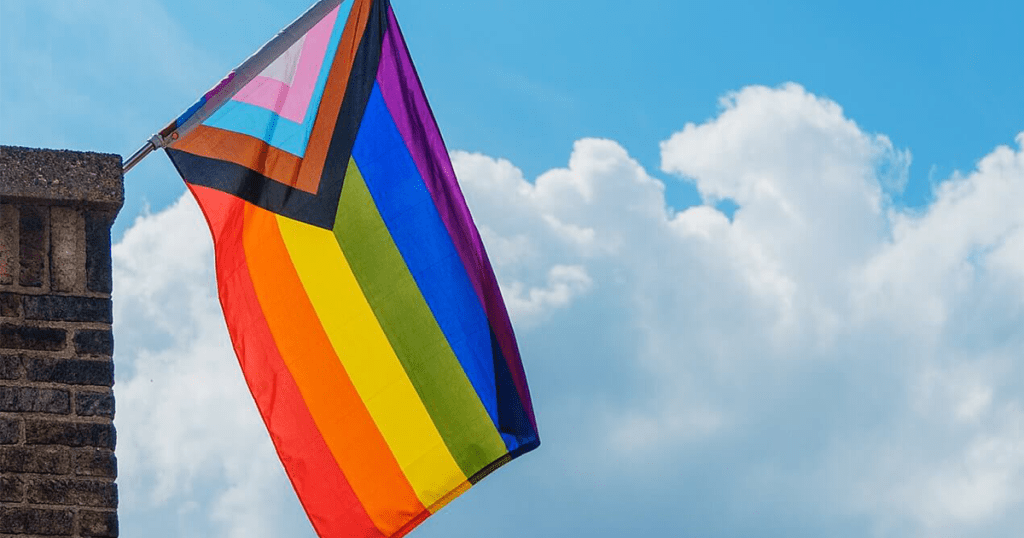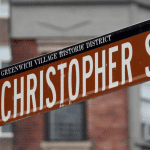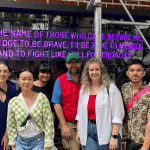Symbols hold profound meaning within the LGBTQ+ community, serving as powerful reminders of the struggles and triumphs that have shaped Queer history. We’ve seen various symbols used over time, not only for the practical use of self-identification within the community, but also, the external symbology of Queer power, pride, and activism. In this post, we’ll explore some of the most iconic LGBTQ+ symbols used throughout history and today.
Recently on tour, a younger guest questioned a historical photo of the Gay Activists Alliance, an early gay rights organization during the days of Gay Liberation. The subjects of the 1970 photo carried banners and wore t-shirts that proudly displayed the lambda symbol (λ) as their prominent marker, and the younger guest was not familiar with that symbol in connection with the LGBTQ+ community. The Gay Activists Alliance was the first to claim lambda as a distinctive symbol equated with the LGBTQ+ rights movement. Originating from ancient Greek culture, the symbol symbolized unity, solidarity, and change, all relevant themes for the broader LGBTQ+ movement. The lambda symbol gained further prominence when it was adopted by the International Gay Rights Congress in Edinburgh in 1974. From there, it became widely recognized as an emblem of LGBTQ+ rights and visibility. The lambda symbol has been used on flags, banners, and other LGBTQ+ paraphernalia, serving as a unifying symbol for the community’s fight for equality and acceptance.

A few years later, the iconic rainbow flag was born. Designed by artist and flag-maker Gilbert Baker in 1978, the rainbow flag quickly became synonymous with the LGBTQ+ community, especially during Pride celebrations. Each color of the flag carries its own significance, with red symbolizing life, orange representing healing, yellow signifying sunlight, green symbolizing nature, blue representing harmony, and violet representing spirit. And as a fun bonus fact: Baker’s original Pride flag also included hot pink representing sex and turquoise representing magic and art.
Over the years, the rainbow flag has evolved to include variations, representing a broader range of identities and communities. Some prominent examples of these variations include the Philadelphia Pride Flag, which features black and brown stripes to represent LGBTQ+ people of color, and the Progress Pride Flag, which incorporates additional colors to represent transgender and nonbinary individuals.
One of the variations, in particular, is the transgender pride flag. Designed by transgender activist Monica Helms in 1999, the flag features stripes of light blue, pink, and white, with blue representing masculinity, pink representing femininity, and white representing nonbinary or gender-neutral identities. Since its creation, the transgender pride flag has gained widespread recognition and has been adopted by transgender communities around the world as a symbol of resilience and empowerment.

Although the rainbow flag and the various variations have become commonplace, there is one particular symbol that resonates with us most in regards to history and activist: the pink triangle. Similar to the word “Queer,” the pink triangle has been reclaimed by the LGBTQ+ community after it was once used as an oppressive and discriminatory marker during the Holocaust. The Nazi regime used the pink triangle as a marker on gay men after they were taken to concentration camps and persecuted. However, the pink triangle was reclaimed in the 1980s during the height of AIDS activism. The AIDS Coalition to Unleash Power (ACT UP), formed in 1987, prominently featured a pink triangle with the text “SILENCE=DEATH.” This new usage of the pink triangle led to an evolution of gay power and gay rights during the AIDS epidemic and beyond.

As we reflect on some of the early symbols within our community, we’re reminded of the power, resilience, and strength of the LGBTQ+ movement, and how so many individuals (as well as the collective whole) have come together, despite monumental challenges, to find community, joy, and resistance.
Learn all of this and more on one of our LGBTQ+ walking tours! Check out our Village Pride tour and Downtown LGBTQ+ Activism tour. Click the button below to learn more and join a tour!







